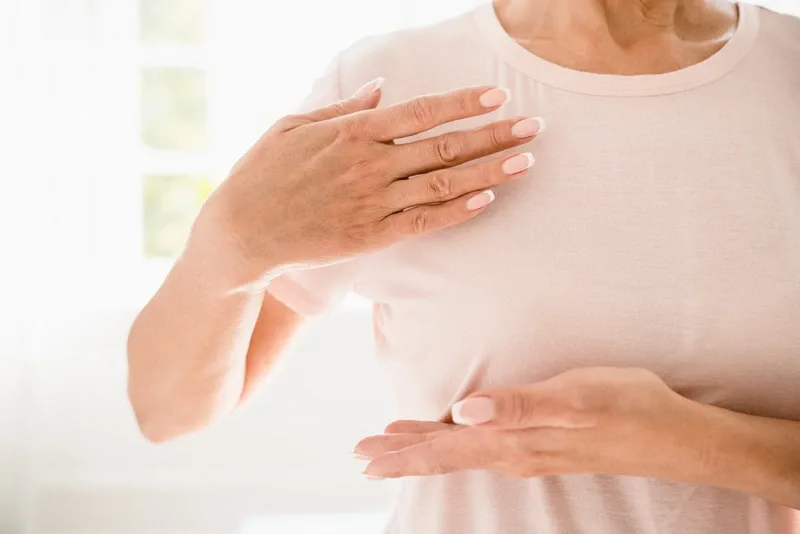Menopause marks a natural transition in life, bringing hormonal changes that affect the entire body — including breast tissue. Declining estrogen levels can lead to changes in breast density, tenderness, and overall composition. These shifts make regular mammograms essential before and after menopause.(1)(2)
Knowing how menopause impacts breast health and the role mammograms play in the early detection of breast cancer is crucial for women in their 40s, 50s, and 60s. This guide explores mammogram recommendations by age, the impact of menopause on breast tissue, and essential breast cancer screening information for postmenopausal women, while also addressing common concerns and providing clarity on what to expect during this stage of life.
Understanding Mammograms and Menopause
A mammogram is an X-ray of the breast used to detect abnormalities, including early signs of breast cancer. Different types of mammography, including digital and 3D mammography (tomosynthesis), can improve detection rates, particularly in women with dense breast tissue.(1)(3)
How Menopause Affects Screening
Menopause brings hormonal changes that impact breast tissue, often reducing density and making mammograms easier to interpret. However, postmenopausal women using hormone replacement therapy (HRT) may notice that breast tissue density remains stable or even increases, which can complicate mammogram readings. Being familiar with these possible changes can help ensure accurate screening results.(4)(5)
Key Age-Related Changes
Younger women typically have denser breast tissue, which can make mammogram interpretation more challenging. As women grow older, estrogen levels decline, with the breast tissue becoming fattier as they reach postmenopause, therefore improving mammogram accuracy. These age-related shifts are what influence screening frequency recommendations.(3)(6)
When to Start Mammograms
Since hormonal changes during perimenopause and menopause can affect mammogram readings, the recommended age to start mammograms varies by medical guidelines and personal risk factors.
Most organizations suggest beginning at 40 and doing annual or biennial screening. However, women with a family history of breast cancer may need earlier and/or more frequent screenings.(1)(4)
Frequency by Age
Mammogram guidelines are general recommendations and differ between organizations. Individual screening schedules should be decided with a healthcare provider based on personal needs.
Mammograms After 40
Women in their 40s should discuss screening frequency with their doctor, particularly if they have risk factors such as a family history of breast cancer or higher breast density.
While women at low risk may not opt for screening until their mid-40s to 50s, healthcare providers often recommend getting a mammogram every one to two years starting at the age of 40.(4)(7)(8)
Mammograms After 50
For women aged 50 to 65, mammograms are typically advised every one to two years, though individual risk factors may require personalized screening schedules.(3)(4)
After 65, screening frequency may adjust based on health status and risk factors. Most guidelines suggest continuing screenings every one to two years, while others indicate that women in good health can adjust frequency according to healthcare provider guidance.(3)(4)
Are mammograms necessary after age 70?
For women between 70 and 75, regular mammograms are still recommended. Beyond 75, decisions should be based on overall health, life expectancy, and discussion with their healthcare provider.(1)(7)
At what age should a woman stop having mammograms?
There’s no universal age at which women should stop mammograms. Women over 75 should consult their physician to determine if continued screening is beneficial based on their health and personal risk factors.

Mammogram Screening Before, During, and After Menopause
Naturally fluctuating hormone levels during perimenopause can cause shifts in breast density, making abnormalities harder to detect. This means that additional imaging may sometimes be needed.
After menopause, as breast tissue becomes fattier, mammogram clarity is improved. However, because HRT can maintain denser tissue, this sometimes complicates mammogram readings and increases the likelihood of additional imaging.(5)
Mammograms are crucial for early breast cancer detection, but hormonal changes during the menopause transition can increase the chances of false positives and unnecessary procedures. Menopause hormonal shifts may lead to benign conditions like cysts or fibroadenomas, which can result in further imaging or biopsies. These conditions are typically harmless but may cause unnecessary stress.(1)(3)(4)
Checking Breast Tissue After Menopause
Postmenopausal women should continue practicing breast self-awareness and report any changes to their doctor. Clinical breast exams should follow recommended screening guidelines based on age and risk factors.
In the gynecology community, the emphasis has shifted from advising patients to perform routine breast self-exams to promoting breast self-awareness. This approach encourages individuals to regularly touch and familiarize themselves with the texture and feel of their breasts, while also observing th

What happens if someone is recalled after a mammogram?
Being recalled after a mammogram is not uncommon. All it means is additional imaging or tests are needed to clarify findings. It does not necessarily indicate cancer.(1)(9)(10)
Common Reasons for Being Recalled After a Mammogram
Unclear images
Dense breast tissue
Cysts or benign lumps
Calcifications
Asymmetries that require further imaging
What to Expect During a Recall
If more imaging is needed after an initial mammogram, additional tests may include the following:
Secondary diagnostic mammography
Ultrasound
Magnetic resonance imaging (MRI)
In most cases, recalls result in benign findings. It’s important for women to be aware of this and avoid unnecessary worry or stress about follow-up testing until they have more information.
How Menopause Can Affect Recalls
Hormone fluctuations during perimenopause may mean extra imaging to ensure an accurate diagnosis. The side effects of HRT during postmenopause may also increase false positives and recall rates.
The Mammogram Journey After Menopause
Regular mammograms remain an essential part of breast health during and after menopause. As hormonal changes alter breast tissue composition, understanding screening recommendations by age and individual risk factors can help ensure early detection of potential concerns. While most mammogram recalls result in benign findings, ongoing communication with a healthcare provider can help guide any necessary follow-up.
By staying informed and asking all the necessary questions, women can make confident decisions about their breast health throughout the menopause transition and beyond.